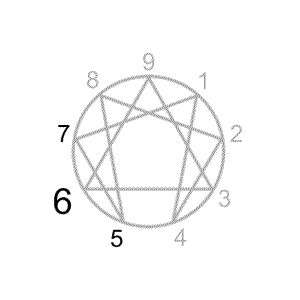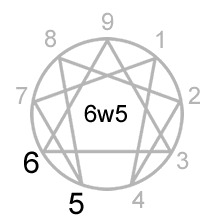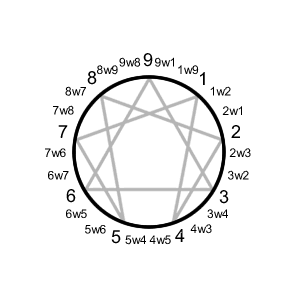Enneagram Type 6 Wings: 6w5 and 6w7
The core focus of Enneagram type 6

Freedom from the desire for an answer is essential to the understanding of a problem.
- Jiddu Krishnamurti
Early in life we develop an initial belief about ourselves and a compensation for that self-belief.
-
Type 6 Initial Self-Belief: “I am uncertain as I am.”
Type 6 Compensation: "I must search for someone or something that I can depend on that provides the assurance to move forward."
Over time this gets generalized beyond the self into a core focus that also shapes how we perceive and interact with the world at large.
-
Type 6 Core Focus: Assurance comes from determining what can be trusted so that internal doubts can be resolved. This requires that I find something outside myself that provides support and can be relied upon by questioning the intentions and thoughts of authorities, systems, other people, and even myself.
Personality characteristics that might arise from the type 6 core focus include:
- Plays the devil's advocate through contrarian thinking
- Tends to notice what could go wrong in situations
- Mentally prepares for worst-case scenarios
- Becomes suspicious when people behave inconsistently
- Projects imagined thoughts and feelings onto others
- Can be very loyal once someone has earned their trust
- Scans the environment and people for possible threats and danger
- Disarms others through warmth and self-deprecation
- Seeks advice and reassurance when making decisions
The wings of Enneagram type 6

The wings are represented by the numbers on either side of a given type as seen on the Enneagram symbol or diagram. These types are said to have an additional influence upon the type being looked at. The wing types for type 6 are type 5 and type 7.
Although type 6 is influenced by both wings, an individual will generally be influenced more by one of the wings than the other. The wing with more influence is said to be the preferred or dominant wing.
-
6 wing 5 (6w5) - preferred 5 wing
Common Name: The Defender- more contrary and serious
- more dutiful and responsible
- more anti-authoritarian and reactionary
-
6 wing 7 (6w7) - preferred 7 wing
Common Name: The Buddy- more self-deprecating and disarming
- more dependent upon others
- more eager to be liked and have fun
What Enneagram authors say about 6w5 and 6w7


Below are samplings from some popular or well-known Enneagram authors. Click on the sources after the descriptions to further explore these interpretations.
-
The Six with a Five-Wing: The Defender
People of this subtype often excel at various kinds of technical expertise, making them outstanding practical problem-solvers, analysts, social commentators, teachers, and opinion leaders. They are more independent and serious than the other subtype, and less likely to go to others for reassurance or advice.1The Six with a Seven-Wing: The Buddy
People of this subtype combine interpersonal qualities with energy, humor, and a a zest for experience. While sociable, they are also visibly insecure and depend on loved ones for reassurance and advice before coming to important decisions.1 -
Six with a Five Wing (6w5): These Sixes may have a scholarly bent and are oen drawn to systems of thought, method, or philosophy. They appear more se2
Six with a Seven Wing (6w7): These Sixes are oen interested in exploring and participating, seeking guidance through interaction. They are more outwardly energetic and sca2
-
Sixes with a Five wing may be more internally focused and passionate about information gathering.3
Sixes with a Seven wing may be more upbeat and risk-taking.3
-
Enneagram Type 6w5 by Ian Morgan Cron
Enneagram Type 6w7 by Ian Morgan Cron
Sixes with a Five wing (6w5) are more introverted, intellectual, cautious, self-controlled and apt to seek security through allegiance to an authority figure. They gravitate toward a defined belief system and a group that shares their values.4
Sixes with a Seven wing (6w7) are far more extroverted and willing to sacrifice themselves for loved ones than Sixes with five wings. Reflecting the playfulness of Seven (the Enthusiast), they are entertaining, animated and adventuresome.4
-
Sixes with a more developed Five wing tend to be more introverted, intellectual, cautious, and standoffish.5
Sixes with a more developed Seven wing tend to be more extroverted, materialistic, active, and impulsive.5
-
Six With a 5 Wing
Sixes with a 5 wing are generally introverted and somewhat intellectual. Can be bookish; some are interested in history or feel rooted in the past or related to a long tradition.6Six With a 7 Wing
Sixes with a 7 wing are generally outgoing and may appear more overtly nervous. More plainly want to be liked and will pursue others in contrast to 5 wing who pulls in.6
Sources
1Book: The Wisdom of the Enneagram
2Book: The Modern Enneagram
4Book: The Road Back to You
5Book: The Enneagram Made Easy
To learn more about the basic type 6 or one of the wing types click on a link below.
Enneagram Tests to Help Determine Wing

The wing types of an Enneagram type are the types on either side of a type as seen on the Enneagram symbol.
Although both the wing types have an influence on the type between them, one wing type is often preferred over the other.
This preferred wing type has a stronger influence than the non-preferred wing type and creates a variation of the type (e.g., 9w8 vs. 9w1).
-
Enneagram Type with Wing Test
This is a very short test that determines your most likely type and preferred wing.
Select from paragraphs, similar to the method used by the
Essential Enneagram Test as found in The Essential Enneagram book.
Use when you want to know your type and preferred wing. -
Enneagram Type Preference Test
This test produces a scored list of all nine types.
Questions are forced-choice, similar to the method used by the Riso-Hudson Enneagram Type Indictor (RHETI).
Use to determine type, wings, gut/heart/head types, and tri-center. -
Enneagram Wing Comparison Test
This test compares the two wings of any type, producing a score for each wing.
Use when you know your type but not your preferred wing. -
Enneagram Type Comparison Test
This test compares any two types, producing a score for each.
Use when not sure which of two types is your primary type and which is your preferred wing type.
Click here for the Complete Guide to the Enneagram.
This free guide explains- the nine Enneagram personality types
- the many type variations within type
- where the types came from (origins and history)
- how the types use the Enneagram symbol
Click here for Enneagram tests.
These free tests help you find your- primary type
- candidate types
- preferred wing
- intinctual subtype
- instinctual variant stacking
- center types (gut, heart, and head)
- tri-center with wings